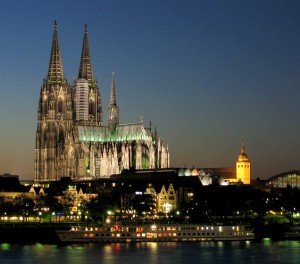 The next four days were going to be a mad dash to the finish. We had one afternoon to explore Cologne. If there is one place one must go when visiting Cologne, it is the cathedral whose gothic spires dominate the city.
The next four days were going to be a mad dash to the finish. We had one afternoon to explore Cologne. If there is one place one must go when visiting Cologne, it is the cathedral whose gothic spires dominate the city.
When Corzoo raised his valve in a professor-ly way on our way to the cathedral, I knew we were going to get a history lesson, and likely a very good one.
“Did you know,” Corzoo said eagerly “that the proper name of this cathedral is Hohe Domkirsche St. Peter und St. Maria?”
“No, I didn’t,” I replied. “What else do you have stored in that noggin of yours that you can share with us about this place?”
“They started building the cathedral in the year 1248 – that’s 763 years ago! But they didn’t finish it until the 1800’s. Work just didn’t happen for about 400 years. Then in the 19th century, there was a resurgence of interest in the Middle Ages and people wanted to finish it according to the original designs. So they formed an organization that raised money, and got it finished.”
“Here’s to those with vision and willpower!” I exclaimed. “And what is this I hear about a box of sacred remains in there?”
“That would be the reliquary.” Corzoo said. “I imagine that I should help you brush up on the definition, right?”
“That would be most helpful, Corzoo,” I said.
“A reliquary is a container of some sort – in this case, a little shrine – that holds relics. And a relic can be the remains of a saint, or part of the remains of the saint – or a lock of hair, or something that a saint wore or used. This reliquary is said to hold the remains of the Magi – the three wise men that visited Jesus after his birth.”
“And did you know,” it was my turn to show off my knowledge “which day Western Christianity celebrates the visit of the Magi – the Three Kings, as they are often called?”
Dave and Corzoo shook their heads.
“That would be January 6th!” And I told them how I myself was expecting a momentous arrival on that day of next year. What a lovely coincidence.
We walked through the front doors of the cathedral – the largest cathedral façade in the world – we proceeded through slowly, trying to absorb as much as possible. It was magnificent and overwhelming to say the least. As we walked away from the cathedral, the sound of the bells summed up the visual impression the place had on us. The long, slow peals were profound, ancient, and fundamental in their sound. A sound meant to awaken a sleeping spirit!
Since I always like to counter potentially overwhelming things with simpler things while traveling, we took a look at one of the Romanesque churches of Cologne – we chose St. Andreas.
Then we went to the Museum Ludwig, which has one of the best collections of modern art in Europe. We loved the German Expressionist collection and particularly enjoyed discovering Max Beckman, with whom none of us had previously been acquainted.
“Why do the people look so weird in these paintings?” Corzoo asked. “They look distorted, and none of them smile.”
“Expressionists weren’t out to recreate reality in their paintings.” Dave said. “They were much more interested in evoking a mood, and it didn’t matter so much that the objects didn’t look like they do in real life. And beauty in the traditional sense was not the main objective.”
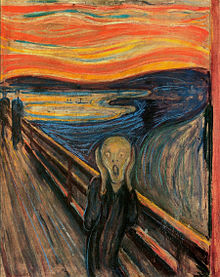 “That’s right,” I added. “Take Edvard Munch’s The Scream, for instance. It doesn’t give you a warm and fuzzy feeling exactly. But it isn’t supposed to. You’re supposed to be able to see and feel a scream.”
“That’s right,” I added. “Take Edvard Munch’s The Scream, for instance. It doesn’t give you a warm and fuzzy feeling exactly. But it isn’t supposed to. You’re supposed to be able to see and feel a scream.”
Corzoo was taking all of the images in. “Is this sort of like what Schoenberg, Berg, and Webern did with music?”
“Yes, exactly!” we replied. These were the main composers of what is known as the Second Viennese School. These composers probably felt like nothing new could be done with tonality that hadn’t already been done, and they were ready to abandon traditional tonal centers and expand into a completely new musical language. They did things differently!
“Like in Pierrot Lunaire,” I said. “where Schoenberg uses sprechstimme instead of the traditional way of singing. The singer’s notes drift on pitches, just like when we speak.”
“I think that is just the coolest effect ever!” exclaimed Corzoo. He launched into an impromptu imitation of sprechstimme. “Des Mondlichs bleiche bluten…” It was especially creepy-sounding in the large, echoing gallery we were in.
“Shhhhh! Corzoo!” I said, as a few other museum-goers looked our direction to see what in the world was going on.
“Well, it fits the mood of the room, doesn’t it?” he asked with a bit too much glee as he gestured towards some of the haunting images that surrounded us.
Later on that evening Corzoo was doing some research on Max Beckman since we liked him the best that day.
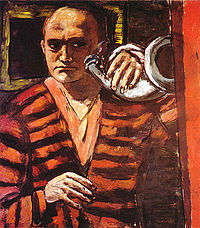 “Look at what I found!” he exclaimed. “It’s a painting of Max Beckman and – me!”
“Look at what I found!” he exclaimed. “It’s a painting of Max Beckman and – me!”
I went over and looked at what he had found. Sure enough – there was a self-portrait of Beckman holding a little instrument that looked remarkably like Corzoo.
“He looks like he’s about to launch into some Berg – maybe a tough lick from Wozzeck!” Dave said, referring to Berg’s most famous opera – an opera that happens to have infamously tricky horn parts.
“Whatever lick is coming up, it has a short life left. KaPOW!” Corzoo jumped with delight as he did a karate kick and punch.
The next day we were off to London, a favorite city of mine. Unfortunately, we once again had a mere couple of hours free in which we could explore.
We were staying close to Kensington Palace and I discovered that they served tea every afternoon in the Orangery. Can you guess where we ended up? Yes! Having tea. There was a wait to be seated but it was worth it. The scones were the best I’d ever eaten – not these dried up things one most often finds in the States. The cream – yum! The tea – perfection, of course.
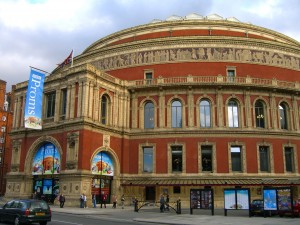 After a short rest, we were off to Royal Albert Hall, the location of the Proms. The Proms are what you might call a Big Deal and definitely a Scene. The feel of these concerts which last over several weeks throughout each summer is more like a rock concert than a typical classical concert. The way you get a ticket for the Proms is the exact opposite of what you would do to get a ticket for, say, the Vienna Opera Ball. Tickets for seats are chosen by lottery, and Prommers, as they are called, line up for hours in advance for the opportunity of buying a standing room seat. Now, the most interesting part is that standing room tickets, rather than being in the back, or way at the tippy-top, are right up front on the ground floor. It is a large space that can hold around a thousand standing concert-goers! Because of all of this, the Proms has been called the most democratic of music festivals. Every one gets a fair chance at attending – you just may have to show how much you want it by your time commitment and your perseverance!
After a short rest, we were off to Royal Albert Hall, the location of the Proms. The Proms are what you might call a Big Deal and definitely a Scene. The feel of these concerts which last over several weeks throughout each summer is more like a rock concert than a typical classical concert. The way you get a ticket for the Proms is the exact opposite of what you would do to get a ticket for, say, the Vienna Opera Ball. Tickets for seats are chosen by lottery, and Prommers, as they are called, line up for hours in advance for the opportunity of buying a standing room seat. Now, the most interesting part is that standing room tickets, rather than being in the back, or way at the tippy-top, are right up front on the ground floor. It is a large space that can hold around a thousand standing concert-goers! Because of all of this, the Proms has been called the most democratic of music festivals. Every one gets a fair chance at attending – you just may have to show how much you want it by your time commitment and your perseverance!
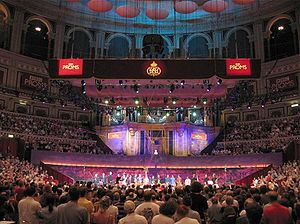 The last night of the Proms is televised by the BBC and is full of tradition. British flags are waved and the mood is celebratory.
The last night of the Proms is televised by the BBC and is full of tradition. British flags are waved and the mood is celebratory.
“Too bad this isn’t the final night.” said Corzoo. “We could hear Elgar’s Pomp and Circumstance and Parry’s Jerusalem!”
“We would have had to camp out for days to get a ticket!” I said.
“I wouldn’t mind one single bit!” said Corzoo.
We went inside the cavernous and famous Royal Albert Hall and looked around while Dave was warming up for rehearsal. It sort of reminded us of a circus venue – circular and massive with its large open concrete floor that was used for standing room.
Corzoo and I headed back to the hotel during the concert. It was sold out, and besides, we had some practicing to do. In a mere few days it was back to work for me, so I had to be in shape.
The next day – Paris! What a tragedy to be in such a beautiful city for just a few hours. I wanted to show Corzoo the Tuileries, the Cluny Museum, the Pantheon, Sacre Couer, Notre Dame, Sainte-Chapelle, and a dozen other places in this beautiful city. But alas, we settled for walking the Champs-Elysees and getting some divine macaroons from Laduree. One could spend an afternoon in worse ways, I suppose!
“Corzoo – you did it!” I exclaimed. “Your extraordinary adventuring skills have earned you a photo in front of the Arc de Triomphe!”
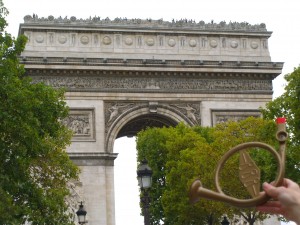 “I’ll come back one day to see and learn more,” he said as he struck a pose in front of that giant monument. “You don’t regret bringing me along, do you?” he said, already knowing the answer.
“I’ll come back one day to see and learn more,” he said as he struck a pose in front of that giant monument. “You don’t regret bringing me along, do you?” he said, already knowing the answer.
“Not for a millisecond!” I exclaimed. Not only did I not regret being cajoled into bringing Corzoo, I rather enjoyed seeing the world through his eyes.
We took off for Philadelphia the next morning after having one last Parisian croissant.
Au revoir, Paris e Europe! We’ll be back someday.
